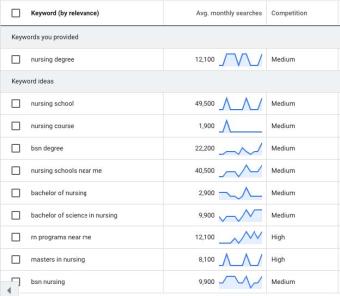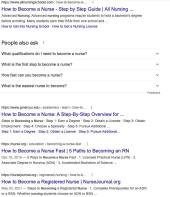Northeastern Policies and Legal Notices
Search Engine Optimization (SEO)
Regular keyword research (and taking action) keeps your website and the content you produce fresh and relevant. The process of keyword research is important because it provides insight into the terms people are using to search for programs or related topics.
It also enables you to gauge how many people are searching for each term through monthly search volume estimates. This process helps you ensure that you’re reaching the right audiences with the right content — and that you are selecting the most valuable
keywords for your content.
WHERE TO FIND KEYWORDS
Using tools like Google Keyword Planner, Ubersuggest, Moz, and Answer the Public, you can begin to figure out what users are searching for, giving you ideas about the types of content you should include on a program page or in blog content.
Not only do Google Keyword Planner and other tools provide you with ideas for potential keywords, but they also give you information about the value of potential terms by identifying the search volume and competition.
- Search volume is the monthly average number of people searching for that keyword.
- Competition is the measure of how many other people are interested in utilizing this keyword for content.
Although Google Keyword Planner exists primarily to identify strong and relevant keywords for paid search campaigns, it is an equally useful tool in identifying keywords for organic search. The keywords it identifies are considered important enough to pay for and compete for in bidding; that indicates they will have important value in organic search as well.
HOW DOES THE KEYWORD RESEARCH PROCESS WORK?
Let’s start with an example using Google Keyword Planner. For example, you might type “nursing degree” in Google Keyword Planner and find other keywords people are searching with, such as “nursing school,” “nursing course,” “bsn degree,” “masters in
nursing,” “bachelor of nursing,” and “bsn nursing.”

Google Keyword Planner will also give you some ideas (on top under broaden your search) for additional keywords you might want to look into.
You can also filter your search by location in Google Keyword Planner to help you see if specific keywords are popular or particularly relevant to your location or geographic area.
TYPES OF KEYWORDS: PRIMARY KEYWORDS, RELATED KEYWORDS, STRIKING DISTANCE, & LONG TAIL
There are several types of keywords you will want to search for and use in your content.
The primary keyword is the search term you want to rank for. It is usually a search term with a relatively high search volume and high relevance to the topic you are writing about or to the website page you are developing content for.
As an example, if you are developing content for a website page about a nursing program, you might consider choosing “nursing degree” as the primary keyword for the page. It has good search volume and high relevance to the topic of your page and is something you would want to rank for in search engine results.
But, using primary keywords is not enough. There’s an old SEO joke that starts:
"An SEO expert walks into a bar, a tavern, a pub, a watering hole, a dive, and an alehouse.."
Everyone loves variety, Google is no exception. Look for synonyms and variations of the keywords. Google loves synonyms and variance and rewards the variance when it comes to SEO. Why? Because it demonstrates to the search engine that you have the
knowledge to answer a user’s search query and the depth of knowledge to talk about a subject authoritatively. So think about related keywords that you might use in writing good content.
For instance, for that nursing degree article, terms like “health professional degree,” “health science degree,” “nursing education,” “nursing qualifications,” “qualities of a good nurse,” and “nursing leadership skills” all support in telling your story and showing the depth of your expertise in providing a user with information that they are looking for.
Another important factor we consider when picking keywords strategically is striking distance keywords. These are keywords that you are not currently ranking for on page one, but that you are ranking for on page two or three of search engine results pages (SERP). This identifies an opportunity to move up in page rank — with a little extra effort — through the content you produce. You could say these keywords have the strongest immediate potential for improving ranking.
Along with primary keywords, we also have to choose related keywords for the content we produce. Related keywords are the supporters of the primary keywords, however, they are just as important because they aid in clarifying search intent, providing more detail on the topic, and increasing your subject matter authority. For example, if a primary keyword for an article is “nursing jobs,” related keywords may be terms like “nursing skills,” “nursing degree,” and “how to become a nurse.”
You can go a step even further beyond primary and related keywords: think about your audience and the kinds of questions they might ask or frequently ask. Many keyword searches use long-tail keywords/phrases — keyword phrases with three or more words — when looking for information, often phrased in the form of a question, just as they would if they asked a question out loud. So,

think about keywords like “how do I become a nurse,” “how long does it take to become a nurse,” and “what is a bsn.” (Just as a note, when doing keyword research in a tool like Google Keyword Planner, keywords are always expressed in lower case and unpunctuated. When you are using keywords in content, normal capitalization rules and punctuation apply.)
Try doing your own search with the keywords you’ve identified to give you an idea of the type of content that is ranking for those words, what your competition is doing, and what kind of content you need to create that will stand above the rest.
The “People also ask” section in many search results can give you some ideas of the kinds of questions that people are using in search terms and that you might be able to answer with your content.
Frequently, these questions are in themselves long-tail keyword phrases that you can do further research with or use within your own unique content.
These types of keywords also come into play with newer trends in search. Long-tail keywords, keyword combinations phrased like questions, and the "People also ask" section all point to the need to address the rising importance of voice search and the ability to rank on smart devices — as well as the ability to rank prominently in featured snippets/position zero on the SERP. (Position zero content appears on top above the regular search results, hence the “zero” position on the SERP.)
With the increase in the use of devices like Alexa that allow you to ask questions about anything, these keywords are perfect companions, since they can reflect precisely what a user might ask the device. And with featured snippets highlighted prominently on top in position zero to answer searchers’ queries, potentially you might even be ranked on page two of Google and still be displayed on top if your content does a great job of answering the user’s search intent. And when it comes to ranking on the SERP, it's all about location, location, location — this type of placement can significantly increase the click-through rate for a website page or blog article.
[underline]Google uses a complicated algorithm[/underline] to decide what pages rank at the top of the rankings, so looking at the competition, doing a few searches of your own, and digging into what people are asking will give you an idea of what Google is looking for. You can now take the aspects that make these pages successful and add your personal touches to your content about similar topics.
HOW TO CHOOSE WHICH KEYWORDS TO USE
When choosing keywords, it’s important to keep a few things in mind. Search volume is very important, but it’s not just about the numbers. Identifying well-rounded keywords that have great search volume is important, but it must be balanced with:
- Topic relevance and preferences
- Ability to be used naturally within the text
- Appropriateness for the intended audience/topic
- Strategic considerations such as boosting striking distance keywords
- Creating content that supports institutional priorities, events, or complements digital campaigns/advertising
This is where long-tail keywords can become extremely useful. Since they are often actual questions posed by users in search, long-tail keywords can further clarify audience search intent and can be used very naturally within the content. For instance, a longtail keyword phrase like “how do i become a nurse” can be used in a title, in the context of an article, or as a subheading that breaks up the article into sections.
When researching keywords, don’t get too specific or narrow; for instance, if you are writing about a paralegal program, including long-tail keywords such as, “how to get a paralegal studies degree” or “how to become a paralegal” ensures you’re reaching people who have demonstrated in their search intent an active interest in learning about the next steps required to become a paralegal.
It’s usually not hard to find long-tail keywords with high search volume — it’s a win-win!
WHERE TO INCLUDE KEYWORDS
Google’s algorithms have come a long way in the past decade or so, and today, they’re amazingly good at understanding the meaning behind words (semantics). Still, if you want to rank for a certain keyword, then you’ve got to use it and show Google that word is central to what you’re writing about.
You can do this by including keywords in:
- Title tag
- Your title tag should always include your primary keyword.
- Headers and subheaders
- Meta descriptions
- You should create a unique meta description for every website page/blog post and it must include your primary keyword.
- Page content
- In addition to your title tag, use your primary keyword within the first 300 words or so of your content and several times after in a way that sounds “natural.”
- Alt text
- For accessibility and SEO, make sure every image contains descriptive alt text using keywords.
- URL
- Although it is not absolutely necessary to include your primary keyword in the URL it is good practice — it helps to reinforce your audience’s expectation of what the content is going to be about.
- Crosslinks to other relevant pages internally or any external sources
Before you get too carried away with keywords, though, remember that your user comes first. Just stuffing keywords into your text at every opportunity isn’t going to look or feel natural, and it’s going to put human readers off.
WRITING FOR SEO CONTENT: BEST PRACTICES
There are also best practices to keep in mind when you are writing for SEO. Success doesn’t come just from dropping keywords into your content, it comes from creating content that brings value to your reader, is easy to consume, and uses SEO keywords effectively.
Always remember that you are writing for human readers first but are including the keywords for search engines. The content should appeal to both.
- Do not stuff keywords. Keywords should appear "normally" in the text and subheads. How many times do you use a keyword or keyword phrase? There is no magic number — just very general guidelines.
- For long-form content (1900-2500 words), you can aim to use the primary keyword phrase anywhere from three to eight times, but only in a way that seems natural. Just make sure you do use it in the title and early in the content, within the first 300 words approximately.
- For short-form content (650-850 words), aim to include the keyword about three to four times.
- Scatter related keywords throughout in text. There is no need to overuse any one keyword when there are many variations and synonyms of the same keyword phrase that are relevant and can also rank for SEO purposes.
- Include the primary keyword in the title/headline. Ideally at the beginning of the title, if possible. With the increased use of AI, Google has become much more flexible about slight variations in a keyword; for instance, nurse, nurses, nursing will all have the same keyword value.
- You can break up keyword phrases with punctuation.
- For example, a keyword phrase such as “criminal justice degree jobs” could be used intact in a title or subheading. But it can also be used differently in the text in a sentence such as: “With a criminal justice degree, jobs are plentiful.” Even with the punctuation, Google will still recognize it as the keyword phrase.
- Do not force a keyword into the copy. The use of the keyword should feel natural. Read your content out loud; if it sounds awkward when you hear it, it will be awkward when your reader reads it.
- Break your page down into easy-to-read sections that are scannable.
- Use subheadings, especially in long-form pages, and Include a keyword whenever possible (primary or secondary keyword).
- Subheadings make your content easily scannable, easier to read and present an easy opportunity to use some important keywords.
- Avoid thin content.
- For best SEO results, articles should vary in length between short form and long form content; as a general rule, long form content averages 1900-2500 words; short form content averages between 650-1000 words
- Write a unique meta description to describe the entire page in one or two sentences. Try to include a call to action as part of the meta description when it is appropriate (i.e. read more, learn how.
- Add an image to pages and include an image alt tag/text to describe the image. Include a keyword as part of the alt text.
- Show subject matter expertise and use statistics (if appropriate) from reliable and credited sources.
- Include links to other key web pages on your site, where applicable. Relevant internal website pages (such as other published blog content or related programs) should be linked to within the text; use keywords in the links wherever possible.
- While it is good to occasionally link to reputable external sources (for instance to studies, relevant professional organizations, statistical information, and government sites such as the Bureau of Labor Statistics) it is best to try to keep the reader exploring within your website; if changes are made to your website make sure to update any referral links
- Every article should end with a clear call to action inviting readers to explore and get more information on your program page; make sure you link the text to the program page and use keywords.
- Instead of writing and linking: “Please visit our website for more information,” instead write: “Please visit our nursing program page for more information about our nursing degrees” and link the phrase to the appropriate program page.
- Regular publication is important for SEO; it means that search engines always have something new to crawl and index; it is best to keep a steady cadence of publication.
A big part of SEO success is making sure you follow best practices when using keywords — and that includes paying close attention to the Do’s as well as the Don’ts.

